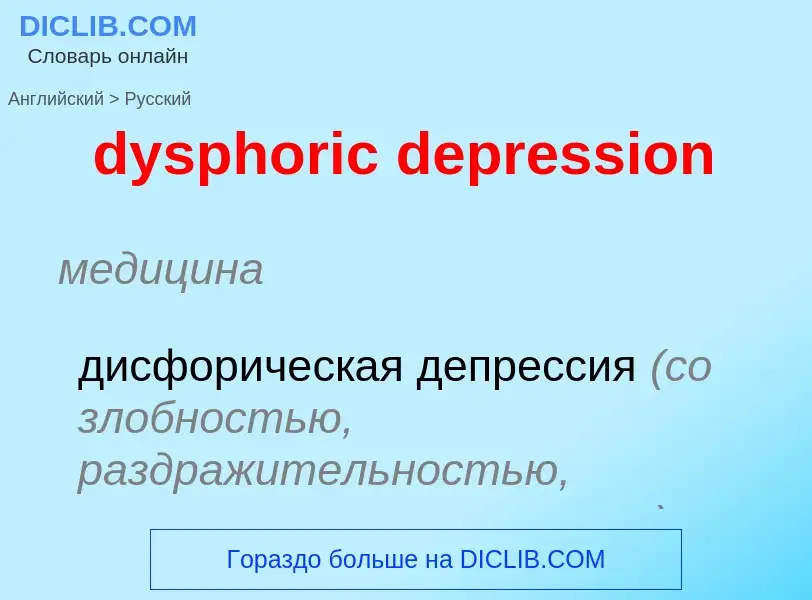Vertaling en analyse van woorden door kunstmatige intelligentie ChatGPT
Op deze pagina kunt u een gedetailleerde analyse krijgen van een woord of zin, geproduceerd met behulp van de beste kunstmatige intelligentietechnologie tot nu toe:
- hoe het woord wordt gebruikt
- gebruiksfrequentie
- het wordt vaker gebruikt in mondelinge of schriftelijke toespraken
- opties voor woordvertaling
- Gebruiksvoorbeelden (meerdere zinnen met vertaling)
- etymologie
dysphoric depression - vertaling naar russisch
медицина
дисфорическая депрессия (со злобностью, раздражительностью, неприязнью к окружающим)
[dis'peəriŋ]
прилагательное
общая лексика
отчаянный
безнадёжный
Wikipedia
Premenstrual dysphoric disorder (PMDD) is a mood disorder characterized by emotional, cognitive, and physical symptoms that cause significant distress or impairment in menstruating women during the luteal phase of the menstrual cycle. The symptoms occur in the luteal phase (between ovulation and menses), improve within a few days after the onset of menses, and are minimal or absent in the week after menses. PMDD has a profound impact on a person's quality of life and dramatically increases the risk of suicidal ideation and even suicide attempts. Many women of reproductive age experience discomfort or mild mood changes prior to menstruation. However, 5-8% experience severe premenstrual syndrome causing significant distress or functional impairment. Within this population of reproductive age, some will meet the criteria for PMDD.
The exact cause of PMDD is currently unknown. However, because the symptoms are only present during ovulatory cycles and resolve after menses, it is believed to be caused by fluctuations in gonadal sex hormones or variations in sensitivity to sex hormones.
In 2017, researchers at the National Institutes of Health discovered that women with PMDD have genetic changes that make their emotional regulatory pathways more sensitive to estrogen and progesterone, as well as their chemical derivatives. The researchers believe that this increased sensitivity may be responsible for PMDD symptoms.
Some studies have suggested that those with PMDD are more at risk of developing postpartum depression after pregnancy, but other evidence has been found to suggest against that notion. PMDD was added to the list of depressive disorders in the Diagnostic and Statistical Manual of Mental Disorders in 2013. It has 11 main symptoms, and a woman has to exhibit at least five to be diagnosed with PMDD. Roughly 20% of females have some symptoms of PMDD, but either have less than five or do not have functional impairment.
First line treatment for PMDD is with selective serotonin reuptake inhibitors (SSRIs). Hormonal therapy with oral contraceptives that contain drospirenone have demonstrated efficiency in reducing PMDD symptoms as well. Cognitive behavioral therapy, whether in combination with SSRIs or alone, has shown to be effective in reducing impairment. Dietary modifications and exercise may also be helpful, but studies investigating these treatments have not demonstrated efficacy in reducing PMDD symptoms.


![Allegory on melancholy, from circa 1729–40, etching and engraving, dimensions of the sheet: 42 × 25.7 cm, in the [[Metropolitan Museum of Art]] (New York City) Allegory on melancholy, from circa 1729–40, etching and engraving, dimensions of the sheet: 42 × 25.7 cm, in the [[Metropolitan Museum of Art]] (New York City)](https://commons.wikimedia.org/wiki/Special:FilePath/Allegory on Melancholy Met DP885774.jpg?width=200)
